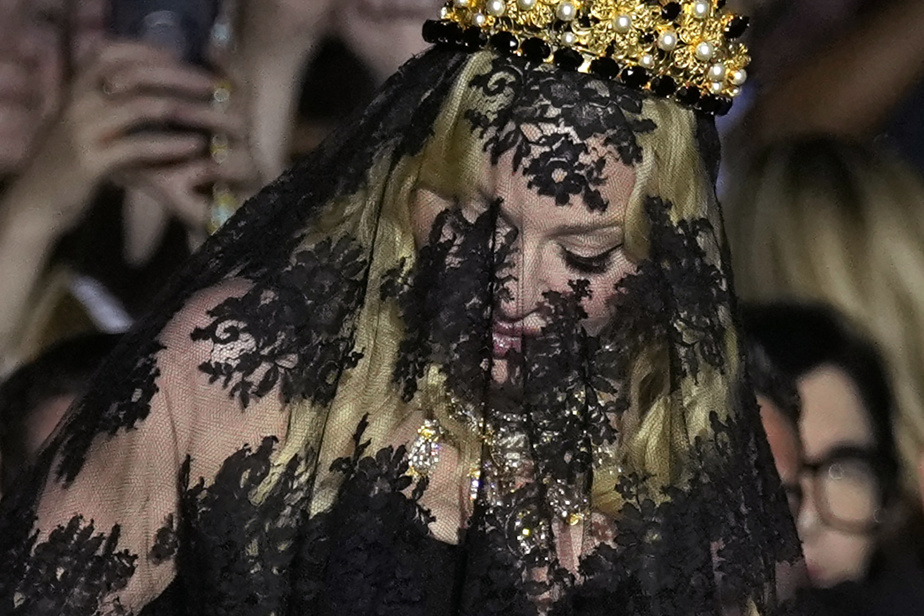(Milan) As Milan Fashion Week draws to a close, Bottega Veneta’s show on Saturday is one of the most anticipated, by fashionistas, the intelligentsia who love the cultural commitment of artistic director Matthieu Blazy, but also by investors who are monitoring the growth of its sales.
Earlier Saturday, the fashion world was treated to a surprise at the Dolce & Gabbana show with Madonna, covered in a veil that barely revealed her face. On the runway, every outfit was a tribute to the Material Girl : all the models wore blonde wigs, reminiscent of Madonna’s Vogue period, and wore corsets with pointed breasts to black men’s outfits with suspenders.
Saturday night at 8 p.m. (2 p.m. Eastern time), the spotlight will be on the Bottega Veneta show.
Founded in 1966 in Vicenza in Veneto, the house, famous for its leather goods and excellent craftsmanship, joined the Kering group in 2001. And as the locomotive Gucci is experiencing difficulties with a 20% drop in its sales, the group intends to make the most of this asset in its game.
But all things considered. Because while Gucci’s turnover, although down, is 4.1 billion euros (6.2 billion Canadian dollars) over the first half, that of Bottega Veneta amounts more modestly to 836 million euros (1.3 billion Canadian dollars) over the same period, with a growth of 3% in comparable data. A drop in the ocean of Kering, but which has its importance and which is accompanied by a unique approach to fashion.
Being cult without social media
Bottega Veneta stands out by playing on discreet hyper exclusivity, masterfully led by its artistic director, Matthieu Blazy, who arrived at the head of creation of the house at the end of 2021.
Franco-Belgian, living between Antwerp and Milan, he began his career in fashion as a men’s designer for Raf Simons before joining Maison Martin Margiela.
He moved to Céline, then Calvin Klein, and was finally called to head ready-to-wear at Bottega Veneta. His vision is based on the power of the Venetian house’s know-how and craftsmanship.
The materials used flirt with trompe-l’oeil and iconic pieces, like these jeans-like pants made of calfskin, which sell in stores for 5,200 euros (nearly 8,000 Canadian dollars).
The cult is then fueled by sharp choices: a logo never affixed to the products, preferring the distinctive signs of its “intrecciato” – the famous braided leather signature of the house or its “nodo”, a large brass knot affixed to bags, shoes and other accessories.
An orchestrated absence from social networks: in 2021, the house deleted its Instagram account, which was followed by millions of subscribers – that was without counting on the responsiveness of admirers who took over the unofficial account “newbottega” to not miss any of the house’s news.
She multiplies the “arty” initiatives – like the publication of a “fanzine” every six months, printed in a very limited edition and distributed drop by drop, but free in the stores. It has of course become a cult object since its first issue and sells out in less than an hour after its arrival in stores.
Passionate about contemporary art and design, Matthieu Blazy fuels the brand’s projects by working with photographers, artists, and designers, with important collaborations often revealed during fashion shows: the 400 chairs, each one different from the other, by Italian designer Gaetano Pesce (who died last April), the reinterpretation of Le Corbusier’s 1952 Cabanon Stool with Cassina during the house’s Winter 24 fashion show.
Until the recent opening of Palazzo Van Axel in Venice. A hybrid project of super exclusive experience for VICs, Very Important Clients, invited to discover the universe of the brand in a completely restored palace in the heart of the Serenissima.
There, personalized services are offered to them: the possibility of choosing from among refined leathers not available in stores, of ordering unique pieces, of accessing the best of artistic craftsmanship. The Palace will also host exhibitions, special projects and in November, the presentation of the Haute Joaillerie collection.
